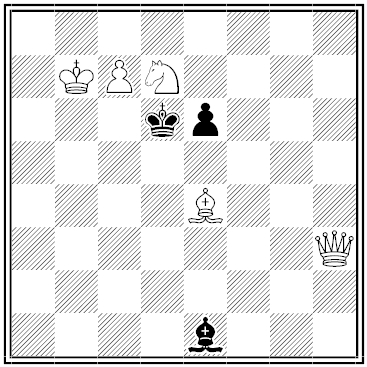Roots
In the old times these isles lay there as they do now, with the wild sea round them. The men who had their homes there knew naught of the rest of the world and none knew of them. The storms of years beat on the high white cliffs, and the wild beasts had their lairs in the woods, and the birds built in trees or reeds with no one to fright them. A large part of the land was in woods and swamps. There were no roads, no streets, not a bridge or a house to be seen. The homes of these wild tribes were mere huts with roofs of straw. They hid them in thick woods, and made a ditch round them and a low wall of mud or the trunks of trees. They ate the flesh of their flocks for food, for they did not know how to raise corn or wheat. They knew how to weave the reeds that grew in their swamps, and they could make a coarse kind of cloth, and a rude sort of ware out of the clay of the earth. From their rush work they made boats, and put the skins of beasts on them to make them tight and strong. They had swords made from tin and a red ore. But these swords were of a queer shape and so soft that they could be bent with a hard blow.
— Helen W. Pierson, History of England in Words of One Syllable, 1884
Art Appreciation
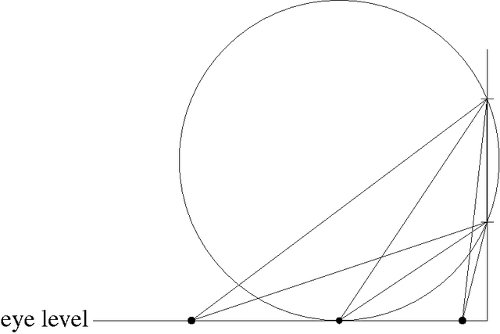
If we stand immediately below a painting in a gallery, it appears foreshortened. But if we stand on the other side of the room, it appears small. Somewhere between these two points must be the optimum viewing position, where the painting fills the widest possible angle in our vision. How can we find it?
The German mathematician Regiomontanus posed this question in 1471. We can solve it using calculus, but it also yields to simple geometry: Draw a circle defined by the top and bottom of the painting and our eye level. That’s the point we want — any other point at eye level will define a larger circle, in which the picture makes a smaller chord and subtends a smaller angle.
(Thanks, David.)
In a Word
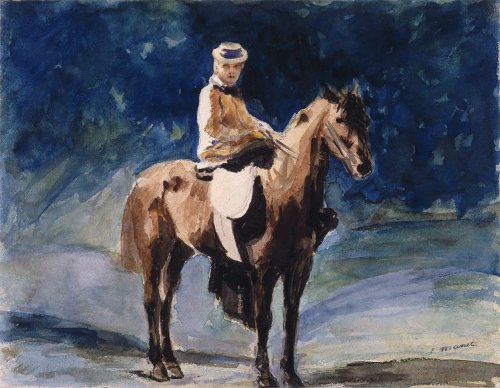
equitation
n. the art of horseback riding
abequitate
v. to ride away
Quick Thinking
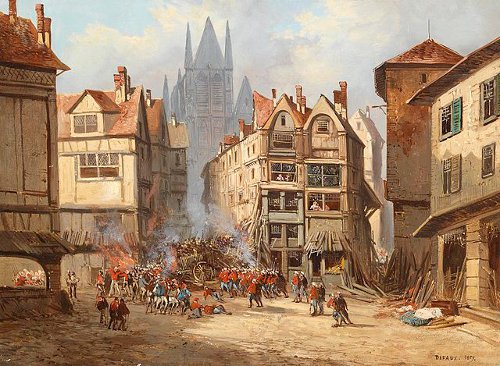
During one of the many nineteenth-century riots in Paris the commander of an army detachment received orders to clear a city square by firing at the canaille (rabble). He commanded his soldiers to take up firing positions, their rifles leveled at the crowd, and as a ghastly silence descended he drew his sword and shouted at the top of his lungs: ‘Mesdames, m’sieurs, I have orders to fire at the canaille. But as I see a great number of honest, respectable citizens before me, I request that they leave so that I can safely shoot the canaille.’ The square was empty in a few minutes.
— American psychiatrist Paul Watzlawick, Change: Principles of Problem Formation and Problem Resolution, 1974
The Nyctograph
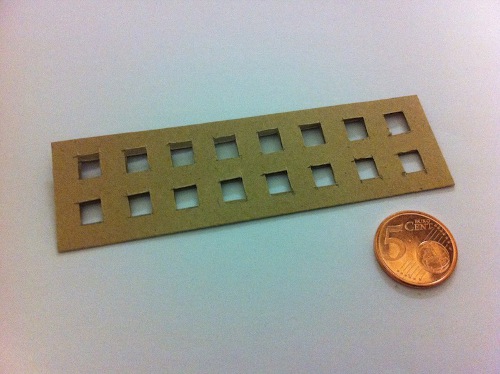
Lewis Carroll was a poor sleeper and did a lot of thinking in bed. The notes he made in the dark often turned out to be illegible the next day, but he didn’t want to go to the trouble of lighting a lamp in order to scribble a few lines.
So in 1891 he invented the nyctograph, a card containing a grid of cells that could guide his writing in the dark, using a peculiar alphabet he invented for the purpose:

“I tried rows of square holes,” he wrote, “each to hold one letter (quarter of an inch square I found a very convenient size), but the letters were still apt to be illegible. Then I said to myself, ‘Why not invent a square alphabet, using only dots at the corners, and lines along the sides?’ I soon found that, to make the writing easy to read, it was necessary to know where each square began. This I secured by the rule that every square-letter should contain a large black dot in the N.W. corner. … [I] succeeded in getting 23 of [the square letters] to have a distinct resemblance to the letters they were to represent.”
“All I have now to do, if I wake and think of something I wish to record, is to draw from under the pillow a small memorandum book containing my Nyctograph, write a few lines, or even a few pages, without even putting the hands outside the bed-clothes, replace the book, and go to sleep again. Think of the number of lonely hours a blind man often spends doing nothing, when he would gladly record his thoughts, and you will realise what a blessing you can confer on him by giving him a small ‘indelible’ memorandum-book, with a piece of paste-board containing rows of square holes, and teaching him the square-alphabet.”
Air Traffic

In 1963, New York inventor Einar Einarsson quietly patented a flying car.
The patent abstract is only two pages long. “The car, after traveling on land, may be easily converted for air travel by removing the stabilizers and wings and placing them in position on the outside of the vehicle. The road wheels may be raised and the propellers are now in position for operation. By suitable adjustment of the wings the car can take off, and when in the air the wings are further adjusted for cruising speed.”
I wonder if he built a prototype …
Equal Opportunity

The Pythagorean theorem works for any similar shapes, not just squares.
In the figure above, A + B = C.
If the three sides of a right triangle are made the diameters of three circles, then the combined area of the two smaller circles equals that of the largest. That’s also the area of the circumcircle, since a right triangle’s hypotenuse forms the diameter of its circumscribing circle.
The Cursing Stone
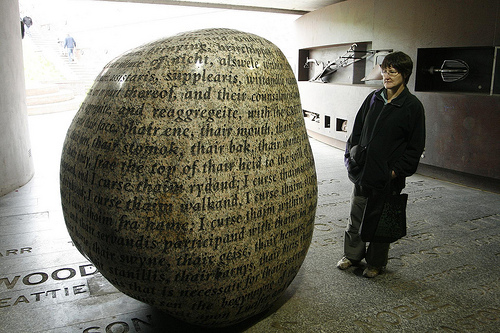
In 1525, fed up with robbers and highwaymen on the Anglo-Scottish border, Archbishop of Glasgow Gavin Dunbar composed a monumentally comprehensive curse against them:
I curse their head and all the hairs of their head; I curse their face, their brain, their mouth, their nose, their tongue, their teeth, their forehead, their shoulders, their breast, their heart, their stomach, their back, their womb, their arms, their legs, their hands, their feet, and every part of their body, from the top of their head to the soles of their feet, before and behind, within and without.
I curse them going and I curse them riding; I curse them standing and I curse them sitting; I curse them eating and I curse them drinking; I curse them rising, and I curse them lying; I curse them at home, I curse them away from home; I curse them within the house, I curse them outside of the house; I curse their wives, their children, and their servants who participate in their deeds; their crops, their cattle, their wool, their sheep, their horses, their swine, their geese, their hens, and all their livestock; their halls, their chambers, their kitchens, their stanchions, their barns, their cowsheds, their barnyards, their cabbage patches, their plows, their harrows, and the goods and houses that are necessary for their sustenance and welfare.
May all the malevolent wishes and curses ever known, since the beginning of the world, to this hour, light on them. May the malediction of God, that fell upon Lucifer and all his fellows, that cast them from the high Heaven to the deep hell, light upon them.
May the fire and the sword that stopped Adam from the gates of Paradise, stop them from the glory of Heaven, until they forebear, and make amends.
May the evil that fell upon cursed Cain, when he slew his brother Abel, needlessly, fall on them for the needless slaughter that they commit daily.
May the malediction that fell upon all the world, man and beast, and all that ever took life, when all were drowned by the flood of Noah, except Noah and his ark, fall upon them and drown them, man and beast, and make this realm free of them, for their wicked sins.
May the thunder and lightning which rained down upon Sodom and Gomorrah and all the lands surrounding them, and burned them for their vile sins, rain down upon them and burn them for their open sins.
May the evil and confusion that fell on the Gigantis for their opression and pride in building the Tower of Babylon, confound them and all their works, for their open callous disregard and oppression.
May all the plagues that fell upon Pharaoh and his people of Egypt, their lands, crops and cattle, fall upon them, their equipment, their places, their lands, their crops and livestock.
May the waters of the Tweed and other waters which they use, drown them, as the Red Sea drowned King Pharaoh and the people of Egypt, preserving God’s people of Israel.
May the earth open, split and cleave, and swallow them straight to hell, as it swallowed cursed Dathan and Abiron, who disobeyed Moses and the command of God.
May the wild fire that reduced Thore and his followers to two-hundred-fifty in number, and others from 14,000 to 7,000 at anys, usurping against Moses and Aaron, servants of God, suddenly burn and consume them daily, for opposing the commands of God and Holy Church.
May the malediction that suddenly fell upon fair Absalom, riding through the wood against his father, King David, when the branches of a tree knocked him from his horse and hanged him by the hair, fall upon these untrue Scotsmen and hang them the same way, that all the world may see.
May the malediction that fell upon Nebuchadnezzar’s lieutenant, Holofernes, making war and savagery upon true Christian men; the malediction that fell upon Judas, Pilate, Herod, and the Jews that crucified Our Lord; and all the plagues and troubles that fell on the city of Jerusalem therefore, and upon Simon Magus for his treachery, bloody Nero, Ditius Magcensius, Olibrius, Julianus Apostita and the rest of the cruel tyrants who slew and murdered Christ’s holy servants, fall upon them for their cruel tyranny and murder of Christian people.
And may all the vengeance that ever was taken since the world began, for open sins, and all the plagues and pestilence that ever fell on man or beast, fall on them for their openly evil ways, senseless slaughter and shedding of innocent blood.
I sever and part them from the church of God, and deliver them immediately to the devil of hell, as the Apostle Paul delivered Corinth.
I bar the entrance of all places they come to, for divine service and ministration of the sacraments of holy church, except the sacrament of infant baptism, only; and I forbid all churchmen to hear their confession or to absolve them of their sins, until they are first humbled by this curse.
I forbid all Christian men or women to have any company with them, eating, drinking, speaking, praying, lying, going, standing, or in any other deed-doing, under the pain of deadly sin.
I discharge all bonds, acts, contracts, oaths, made to them by any persons, out of loyalty, kindness, or personal duty, so long as they sustain this cursing, by which no man will be bound to them, and this will be binding on all men.
I take from them, and cast down all the good deeds that ever they did, or shall do, until they rise from this cursing.
I declare them excluded from all matins, masses, evening prayers, funerals or other prayers, on book or bead; of all pigrimages and alms deeds done, or to be done in holy church or be Christian people, while this curse is in effect.
And, finally, I condemn them perpetually to the deep pit of hell, there to remain with Lucifer and all his fellows, and their bodies to the gallows of Burrow moor, first to be hanged, then ripped and torn by dogs, swine, and other wild beasts, abominable to all the world.
And their candle goes from your sight, as may their souls go from the face of God, and their good reputation from the world, until they forebear their open sins, aforesaid, and rise from this terrible cursing and make satisfaction and penance.
As part of Carlisle’s millennium celebrations in 2001, local artist Gordon Young carved 383 words of the curse into a granite boulder. Since then, local livestock herds have been wiped out by foot-and-mouth disease, a devastating flood has struck the city, factories have closed, and the Carlisle United soccer team dropped a league. Jim Tootle, a local councillor who blamed these misfortunes on the revived curse, himself died suddenly in 2011.
“It is a powerful work of art but it is certainly not part of the occult,” Young insisted. “If I thought my sculpture would have affected one Carlisle United result, I would have smashed it myself years ago.”
(Thanks, NMN.)
Ballot Measure
A Russian problem from the 1999 Mathematical Olympiad:
In an election, each voter writes the names of n candidates on his ballot. Each ballot is then placed into one of n+1 boxes. After the election, it’s noted that each box contains at least one ballot, and that if one ballot is drawn from each box, these n+1 ballots will always have a name in common. Show that for at least one box, there’s a name that appears on all of its ballots.

